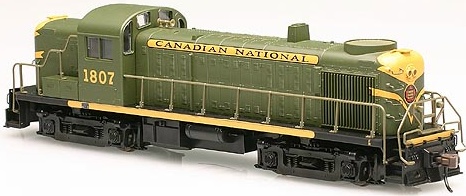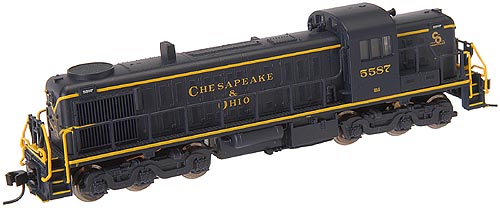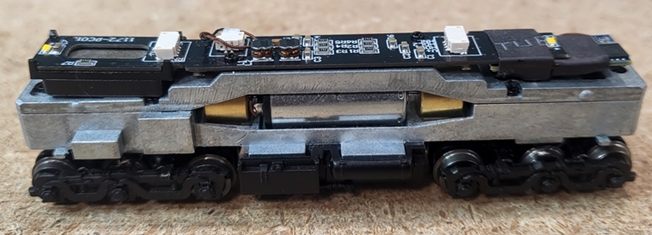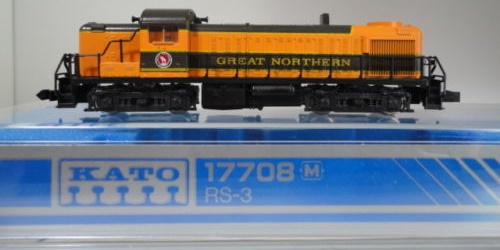



Introduced: 1983 (Kato/Japan RS-3), 1987 (Kato/Japan RSD-4/5), 1999 (Atlas "Classic" RS-3 & RSD-4/5), 2001 (Slow-Speed Motor RS-3), 2004 (Slow-Speed Motor RSD-4/5) and 2024 (DCC-Sound RS-3 and RSD-4/5)
Atlas's RS-3 and RSD-4/5 models share a similar evolution and history. In fact, apart from the trucks (four axles on the RS-3 and six axles on the RSD-4/5), the models are identical (both internally and externally). So, to save myself a bit of time I'm going to cover them both here.
The Atlas/Kato RS-3 represents a watershed moment in N scale history and a huge leap forward in N scale locomotive design (at least as far as North American prototypes are concerned). In late 1981-early 1982, Atlas discontinued their entire line of N scale locomotives, which at the time included F9, GP9, GP30, E7A, FA-1 and Davenport Switcher models (all manufactured by Roco/Austria). Meanwhile, Stephen Schaffan (Atlas' founder) worked arduously (despite illness) to develop the company's Alco RS-3. The first production run of this model arrived in the latter months of 1983. Sadly, Mr. Schaffan did not live to see the fruits of his labors, as he passed away on March 22 of that same year. The RS-3, a widely lauded locomotive, represented the first in what was to be a new generation of Atlas locomotives. A memorium to Mr. Schaffan appeared in the June, 1983 issue of Model Railroader.

Although the first truly "modern" North American diesel model design, I'd say the Atlas/Kato RS-3 was more evolutionary than it was revolutionary. The pick-up design (split-frame metal truck assemblies transferring current to a split-frame metal chassis) is pretty much the same as the one Kato used in their 1967 Alco PA model. And many of the other noteworthy "new" features had already been seen in Kato's 1978 DD-13 centercab switcher (as imported by Con-Cor). EG, the vertically split-frame chassis (which sandwiched the 5-pole motor, driveshafts and worms), the directional lighting scheme (small PC boards mounted on either end of the chassis), the skinny/flexible handrails, and the separate walkway/handrail assembly.

One innovation that the RS-3 had (and that the DD-13 didn't) is the use of bearing blocks to hold the worms firmly in place - a convention used on most everyone's diesel models going forward. On the down side, the original RS-3 design employs open pilots and truck-mounted Rapido-style couplers. Also, it doesn't have flywheels (those wouldn't appear on an Atlas/Kato loco until their 1988 RS-1 model). All axles are geared (with all the gearing being plastic). The first-run of RS-3's came with one traction tire per truck. Later runs featured all-wheel pickup (IE, no traction tires). The wheels are low-profile, so no problems on Code-55 track. After the first RS-3 run, the wheels came "blackened". All of the RSD-4/5's came with blackened wheels and without traction tires.
Performance on these Kato-made models is most excellent. They run smoothly and quietly at all throttle levels. Pickup is flawless, slow-speed creep is superb, and pulling power is impressive (30+ assorted 40' freight cars through curves on level track). The top-end speed is a bit high, but that's a minor nitpick. And running characteristics aside, these things just flat-out look great (especially as compared to the other diesel models available during the early 1980s).
The Kato-made RSD-4/5 came out a few years later and, as mentioned above, apart from the trucks is identical to the RS-3 model.
Atlas eventually severed their ties with Kato in the mid-90s, and in 1999 released completely redesigned Chinese-manufactured RS-3 and RSD-4/5 models (packaged under their "Atlas Classic" line). These models have a new shell and a new chassis (now with flywheels). The old metal truck assemblies are replaced by plastic ones (with current collected via metal axle-cups and transferred to the chassis via flexible brass contact strips). The truck-mounted couplers are upgraded to shell-mounts (still Rapidos, though). And as nice as the earlier Kato-made units ran, these run even better (just a little smoother and quieter).


In 2001, a new Atlas Classic version of the RS-3 was issued (with the RSD-4/5 being similarly upgraded in 2004). New features include separately-applied painted handrails (where appropriate), a slower "scale speed" motor, and factory-installed AccuMate magnetic knuckle couplers.


One thing about the Atlas Classic RSD-4/5 - only four out of the six axles are geared, thus resulting in somewhat diminished pulling power. And why this backward step from the Kato-made models? I dunno, ask Atlas.
Circa 2013, Atlas revised the internals on these models slightly. As pictured below, the hex nuts on the flywheel end of the worm shafts were removed and replaced instead with U-joint connectors -

Atlas released all-new RS-3 and RSD-4/5 models in 2024. These were available either DCC-Ready or with factory-installed ESU LokSound decoders -

These models were redesigned along the lines of the Atlas Trainmaster re-release of the same year. Rather than using the old split-frame chassis to transfer current to the main PC board, the chassis is now essentially one big hunk of metal with wires from the trucks transferring current directly to the board. Additional wires from the board transfer current to the motor contacts. LEDs mounted to either end of the board provide directional lighting. The drivetrain components drop inside of the chassis and a separate metal lid screwed to the top holds everything in place. The main PC board is screwed to the top of the chassis lid. The main PC board comes with a preinstalled speaker on all models. The DCC interface (designed by ESU) is designated as "E24".

Everything else (trucks, fuel tank, shell, etc) look to be the basically same as on the previous Atlas Classic versions, so it should be a simple task to swap shells between the two.

I was a bit disappointed by this new version's performance, it being the first new Atlas DCC-Sound loco that I thought actually took a step backwards in the performance department (as compared to the previous non-sound releases). For starters, this new version is a quite a bit noisier than the previous releases (emitting an annoying barbershop razor buzzing sound as it rolls along, a grating noise which becomes particularly noticeable when throttling up or down). I thought maybe additional lubrication around the bearing blocks might solve this problem (it usually does), but no such luck this time. Of course it's not terribly noticeable with the sound turned on, so maybe the reason the factory settings for volume are turned up so high is to mask said racket. It certainly wouldn't surprise me.
My other complaint is with the pickup. The wheels and axle wipers are absolutely slathered in that irritating wheel blackening crap, and with the end result being all sorts of stalling problems at slow speeds. Out of the box, I couldn't keep mine running for more than a minute or two at speed step 4 (a nice slow crawl). Fortunately, I was able to improve performance significantly by cleaning the wheels and scratching the blackening crud out of the axle wiper cups (the latter being a frustrating procedure that involves completely disassembling the trucks). But even after all that, it still remains a bit finicky about track that isn't freshly cleaned and perfectly spotless, so kind of an annoyance there. On the plus side, the addition of DCC support did not diminish the model's pulling power (or overall weight) at all, so a nice surprise there.
Folks wanting to use DC power to operate one of the "Gold" models should note that analog operations are disabled in the default CV settings for the ESU LokSound 5 Nano sound decoder included with said models. To enable analog operations you need to set CV29 to 14 (default setting is 10) and CV50 to 3 (default setting is 0). It seems that whoever programmed the default settings for these decoders didn't really give a rat's ass about analog operators. Either that or they just really enjoy forcing people to hunt around for online decoder manuals and CV settings 
Trivia - it is possible to find one of the Kato-made models in a box that looks exactly like a contemporary Kato box (including the inserts) and makes no mention of Atlas. What I've been told is that Hobby Center Kato sold all of the Sekisui Kinzoku (IE, Kato) production in their shops in Tokyo and Osaka in Kato boxes (regardless of the US label). Hence, one might have found Con-Cor, Atlas, and Stewart US profile locomotives in Kato boxes with no mention of those brands. The most notable example of this "gray market" is the batch of Atlas GP7s and GP9s that made it into the USA via a distributor which were in standard Kato packaging.

More Trivia - the same Kato RS-3 chassis was used for the Atlas/Kato RS-11, RSD-12, GP7, and GP9 models (all released in 1986/1987). Unfortunately, this cost-saving measure resulted in a whole lot of models that weren't particularly accurate.
Even More trivia - Once upon a time, Bill Denton (Skytop Models) made a "Phase III" replacement shell that is a direct swap for the most recent RS-3 shell (the stock Atlas model represents a "Phase I" RS-3) -

Yet Even More Trivia - Brigg's Models makes MLW RS-3 replacement shells in three different BCR/CP styles that are direct swaps for the most recent RS-3 shell -

Still Yet Even More Trivia - the old Atlas/Kato RS-3 shell is reportedly a good fit for the Life-Like/Walthers RS-2 chassis. Similarly, the Atlas Classic RS-3 shell reportedly fits on a Bachmann RS-3 chassis (although not vice versa). Lastly, it is possible to mount an old Atlas/Kato RS-3 shell on the newer Atlas Classic RS-3 chassis (a set of cab clips must be removed and you need to install a Micro-Trains pilot conversion kit).
Prototype Info -
Well over 1,300 RS-3 road-switcher locomotives were built by ALCO between 1950 and 1956. It can be considered one of the most successful four-axle diesel road-switchers ever produced by the builder. These 1,600 hp locomotives were powered by an ALCO 244 V-12 engine which was complimented by rugged GE electrical components. The RS-3 was truly a versatile locomotive. It could be found in virtually every type of service from passenger and commuter runs to heavy-haul and local freight assignments. Original owners of the RS-3 tended to be in the eastern and central regions of the US (with heavier concentrations in the northeast and southeast). During this same time-period, ALCO offered a six-axle road-switcher which was more commonly found in the west. The RSD-4/5 was externally very similar to the RS-3, having six-axle trucks as an obvious spotting feature. They produced the same 1,600 hp as an RS-3, but offered increased tractive effort due to the use of a larger generator. Many RSD-4/5s were assigned to operate in mountainous territory (with varying degrees of success) on the Southern Pacific, Santa Fe and the Utah Railway.
Features (2024 release) -
- Golden-white LEDs
- Directional lighting
- Separately-applied painted handrails (where appropriate)
- Blackened metal wheels
- Factory-installed AccuMate magnetic knuckle couplers
- Accurate painting and printing
- Both "Silver" and "Gold" models come equipped with a speaker
DCC Features (Gold version) -
- Supports all DCC-programming modes
- DCC includes RailCom and RailComPlus, with 14, 28 or 128 speed steps and with 2-digit and 4-digit addressing.
- Flexible mapping of function keys F0 to F28.
- A total of 6 DCC function outputs are available, and all can be function mapped (disable, brightness, light effects) individually
- Follows all NMRA DCC standards and recommended practices
- Over 20 sound effects are available, including engine start-up and shutdown, prime mover sounds through all eight notches, bell, air horn, air compressor,
dynamic brakes and more
- There are up to 16 user-selectable horns, 2 user-selectable bells, and 2 user-selectable synchronized brake squeals
- Manual and Automatic Notching modes with the ability to change modes "on the fly" are provided for true realism
Shell Removal -
Removing the shell requires a bit of patience and a gentle hand (IE, leave the elbow grease at home). I use a couple of small screwdrivers to pry the shell up and away from the chassis a little bit at a time (starting at one end and working my way around). Eventually it'll slide up and off.
Grades: A (for the non-DCC versions) and B (for the DCC versions)
Kato RS-3 reviewed: 2/84 Railroad Model Crafstman, 1/84 Model Railroader: ("This Atlas model, manufactured in Japan by Kato, is a fine N scale representation of the RS-3 diesel. It closely follows the scale dimensions and proportions of the real locomotive. Except for the concessions usually found in (N scale) models (deep wheel flanges, open platform ends, and large couplers), this engine is as well detailed as many larger scale models. The molded handrails on this model are much smaller in diameter than the ones found on most commercial N scale models. They scale a little over 3" (.020") in diameter, which is pretty good for a plastic N scale model...
"The motor frame has two cast zinc alloy pieces - one right-hand and one left-hand - enclosing a five-pole, open-frame motor, worm shafts and gears, and universal joints... The truck gear-frame assemblies also have insulated metal halves. On each side the truck gear frames make electrical contact with one of the motor frame halves. Thus no wires are needed to complete electrical circuits. The directional headlights are each mounted on a small piece of circuit board with a diode. They plug into clips on the ends of the motor frame assembly. The well-engineered mechanism is easy to assemble and disassemble...
"The scale 41"-diameter metal wheels (40" on the real locomotive) are mounted on plastic axles. One wheel on each side has a traction tire, so each side of the locomotive has three wheels for electrical pickup... The (traction tires) on this model are smooth and true... The wheelset check gauge on our sample was .010" under the recommended standard, but it ran over commercial prefab track and sectional track with no difficulties... The wheel flanges may have to be turned down if you operate the model over commercial Codes 40 and 55 track where there are plastic tabs extending over the top of the rail base... The model runs as smooth as any N scale model I've seen. While the top speed is excessive, it will throttle down very nicely and will run smoothly at the slowest speeds... I like this model a lot. It has fine detail, is simply constructed, soundly engineered, and it runs well... Undec, Pennsylvania, Norfolk & Western, Rock Island, Louisville & Nashville. Price: $39.00")